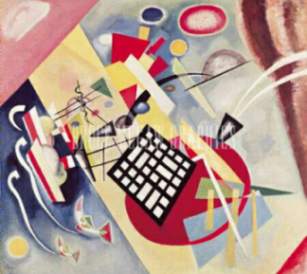 W. Kandinsky, Black Frame, 1922
W. Kandinsky, Black Frame, 1922
Back to Main Page | |||||
| Favorite Sites | Computing | Education |
News | Jobs | Israel |
| Business | W3 Resources | History | Travel | Internet | Russia |
| Entertainment | Books | Art | Science | Languages | Spanish |

 W. Kandinsky, Black Frame, 1922
W. Kandinsky, Black Frame, 1922
 Yixing(pronounced yeeshing) teapots,
early in the sixteenth century, the potters at Ihing, a few miles
up to Yangtze from Shanghai, became famous for teapots known to Europeans by the
Portuguese name boccarro (large mouth). These were small, individual pots. which
came to Europe with teas and served as models for the first European teapots.
Yixing(pronounced yeeshing) teapots,
early in the sixteenth century, the potters at Ihing, a few miles
up to Yangtze from Shanghai, became famous for teapots known to Europeans by the
Portuguese name boccarro (large mouth). These were small, individual pots. which
came to Europe with teas and served as models for the first European teapots.
Other scholars have discounted this history and say that the Chinese, though they provided Europe with her first tea, did not historically use teapots. Instead they brewed tea directly in the cup, letting the leaves sink to the bottom before drinking. Such teacups are still used in many Chinese restaurants today, however the modern productions are clumsy and rough as compared with those turned out during the latter half of the Ming dynasty.
At the beginning of the eighteenth century, the East India Company, recognized the growing demand for such items as teapots and began importation in larger numbers. The increased cargo served an additional function-that of ballast in the trade ships. The company commissioned china directly from Chinese artists and craftsmen, using patterns sent from England and geared to European tastes, stereotypes, and market values. Designs fell into four main areas: mock-ups of Oriental designs (such as "Blue Willow" and "The Tree of Life"), designs adapted from European prints (such as the famous Georgian "house" teapots), armorials (bearing the coat of arms for major European families), and the innovative teapots (such as those with the now standard spout drain on the interior of the teapot). Company directors were especially concerned that teapots not drip and so stain the valuable linen that they also marketed.
In Germany, Johann Bottger of Meissen worked as an alchemist for King Augustus of Poland. Augustus had a penchant for Chinese pottery and wanted gold to buy, among other things, fine teapots. Soon Bottger was instructed to throw all of his energy into discovering a European equivalent to the kaolin rich clay and petuntse rock of Chinese porcelain. The Chinese had been firing pieces of hard porcelain as early as 618 CE -- their idea of porcelain was defined not by color or translucence, but rather by the musical note achieved when a piece was struck. Between 1708 and 1710, Bottger invented a fine stoneware that could be burnished on a lapidary's wheel. But Bottger wanted to make a "hard-paste" material instead of merely imitating and refining earthenware. Around 1710, he found after many trial-and-error effortsthe proper balance of materials to mix into what was to be the first true European porcelain, white with a smooth texture and translucent quality.
In 1710 a major commercial porcelain breakthrough occurred in Europe. After many
trial-and-error efforts, imperial craftsmen found the clay near Meissen,
Germany, coupled with new technology, produced a porcelain equal to the finest
such items available from  distant China.
Nearby Dresden quickly became the center for fine European china.
But by the mid-1700's the technique was being
copied in England and France. As Baroque and Rococo designs began to appear,
they were adapted into porcelain production. Though teapots largely remained
globular in shaped, some pear shaped ones were popular. Spouts were often shaped
as dragons or other animals. Handles were elaborately embellished with scrolls
and similar designs.
distant China.
Nearby Dresden quickly became the center for fine European china.
But by the mid-1700's the technique was being
copied in England and France. As Baroque and Rococo designs began to appear,
they were adapted into porcelain production. Though teapots largely remained
globular in shaped, some pear shaped ones were popular. Spouts were often shaped
as dragons or other animals. Handles were elaborately embellished with scrolls
and similar designs.
In Europe a soft-paste porcelain, made solely from clay and ground glass and fired at 1,200°C, was produced in an effort to duplicate Chinese porcelain. This material was not a true porcelain, being much less hard and fine. The first true European porcelains were developed by Bottger at Meissen in Germany in 1708, but large-scale porcelain manufacture did not begin in the West until new deposits of kaolin were found, such as those in Cornwall, England. These were fired at a temperature of 1,450°C. The first major Western development was the discovery of bone china by the British potter Josiah Spode in about 1800. Spode added calcined bone to hard paste mixes to produce a hybrid porcelain, still widely used in the UK. Porcelain is also a useful engineering ceramic, with properties similar to alumina, that is used in many electrical insulating applications.
 Stash Tea : Teapots
Stash Tea : Teapots
 Yixing : Teapot Information
Yixing : Teapot Information
 Teapots, China & Other Tableware
Teapots, China & Other Tableware
 eBay : Tea Pots, Tea Sets
eBay : Tea Pots, Tea Sets
 Yixing from Museum Company
Yixing from Museum Company
 A History of Teapots
A History of Teapots